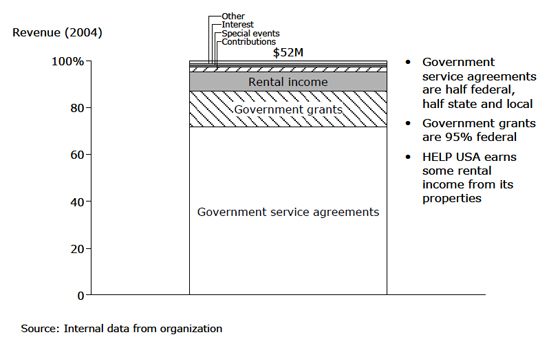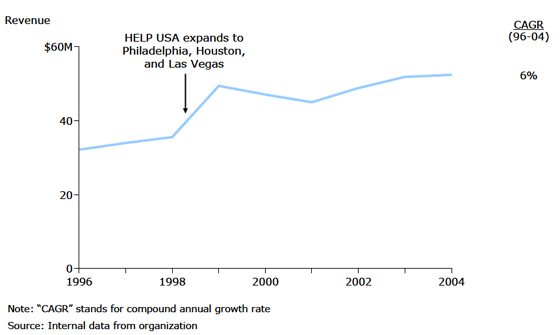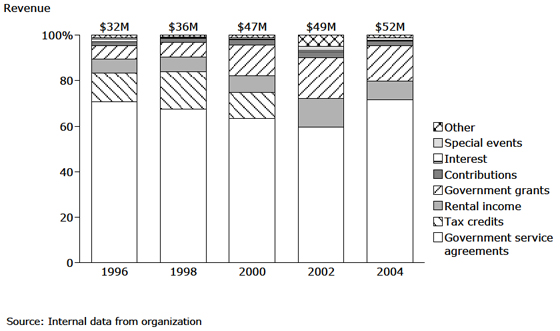It’s not enough to be ‘right,’ and be on the side of ‘justice,’ because there are lots of those organizations. You also have to run it well.
– Larry Belinksy, Chief Executive Officer
Overview
Related Content
How Nonprofits Get Really BigOrganization Profiles from How Nonprofits Get Really Big
Andrew Cuomo founded HELP USA in 1986 as a low-cost, high-impact alternative to New York’s approach of paying hotels to house the homeless (“welfare hotels”). (Cuomo later became HUD Secretary under President Clinton.) HELP USA builds transitional housing facilities, provides comprehensive support services (e.g., case management, education, after school programs, health care, and housing assistance), and transitions homeless families to stable housing faster than welfare hotels and at two-thirds the cost.
The organization has expanded its programming to include permanent housing options as well as welfare-to-work, one-on-one child mentoring, and domestic violence programs. It also has grown geographically, branching out from its New York origins to operate sites in Philadelphia, Las Vegas, and Houston. Now one of the nation’s largest provider of supportive housing, the organization serves more than 5,400 homeless and low-income individuals each day. HELP USA wants to increase its investment in permanent housing going forward.
HELP USA uses low-income housing tax credits to develop its facilities. It relies on government contracts to fund many of its support services as well as its programs that help prevent homelessness. For services that are considered core to its model but not reimbursed by government funding streams (e.g., on-site day care, social services, and security guards), it seeks unrestricted funds from rental income, contributions, and tax credits.
Founding date: 1986
Revenue (2004): $52 million
Structure: Single organization
NCCS classification: Housing and shelter
Services: Provides transitional housing for homeless families along with comprehensive, on-site support services (e.g., job training and placement programs)
Beneficiaries:Homeless and low-income families
Leadership (selected): Larry Belinsky, Chief Executive Officer
Address: 5 Hanover Square, New York, NY 10004
Website: www.helpusa.org

Growth Story
- 1986 – Andrew Cuomo founds HELP USA as a low-cost, high-impact alternative to New York’s approach of paying hotels to house the homeless. His vision is to build transitional housing with comprehensive, onsite social services, believing that housing alone is not sufficient.
- 1987 – HELP USA opens its first transitional housing site. Two projects in the Bronx follow, funded by tax exempt bonds.
- 1998 – Congress names HELP USA as a demonstration model.
- 1990 – The organization launches its first project for people with AIDS.
- 1992 – HELP USA begins to offer a permanent housing option with less intensive support than its transitional model. It funds the project with state and city loans and with the proceeds from the sale of low-income housing tax credits.
- 1995 – The organization opens a flagship permanent housing project in the heart of Manhattan. The project proves that housing the homeless is feasible (both economically and politically) even in Manhattan. Later that year, Mentoring USA joins HELP USA, providing one-to-one site-based mentoring in select schools for at-risk, inner city kids.
- 1998 - 1999 HELP USA expands to Philadelphia, Las Vegas, and Houston.
- 2004 – HELP USA houses its 100,000th family.
Revenue Trends
Revenue growth: HELP USA‘s steady growth in New York was punctuated by geographic expansion in the late 1990s.

Funding mix: HELP USA is working to increase its rental income and private contributions to access greater unrestricted funds. From 2002 to 2004, the organization did not tap into low-income housing tax credits, but it does intend to do so going forward.

Actions That Helped Propel Growth in Funding
- Proved its cost effectiveness. A key source of HELP USA’s appeal to government funders is its ability to demonstrate better outcomes for two-thirds the cost.
- Evolved while staying true to its mission. HELP USA has been able to survive peaks and troughs in funding by avoiding programs that it cannot sustain. The organization has demonstrated an ability to evolve while staying true to its mission, moving into projects that have both market rate and subsidized units with the goal of generating surpluses that can subsidize additional services for beneficiaries.
- Managed the organization aggressively. Developing and operating transitional housing is a financially complex endeavor. Doing it well required HELP USA to develop a strong finance function. Half of the organization’s 60 central-office employees are in the finance and accounting area.
- Maintained an engaged board. HELP USA’s board has played a critical role explaining to the community what the organization does, thereby building community support and generating funding.
Funding Challenges
- Funding support services. The restrictive nature of HELP USA’s government funding has constrained the organization’s ability to offer support services. The government funds only a limited service set at transitional shelters and no services at permanent housing facilities. In response, HELP USA is working to generate rental income and to raise other sources of unrestricted funds.
- Responding to shifts in government funding priorities. In 2002 government funding sources for homelessness initiatives began to shift from bricks and mortar projects to programs aimed at preventing homelessness—threatening to make HELP USA’s government fundraising efforts more difficult.

